Ce que le Chevalier couvert de cendres a raconté à son retour
Pigment and acrylic on canvas mounted on stretcher
260.5 × 868 cm (102 9/16 × 341 3/4 in.)
These two fresco paintings by Hélène Delprat, entitled Ce que le Chevalier couvert de cendres a raconté à son retour and Où l'on découvre des merveilles hydrauliques et bizarres, reveal the breadth of her influences and her cinematographic, literary, philosophical, pictorial, and musical references, which she describes as a “jumble”: from Ovid's Metamorphoses to Cocteau, from the Boboli Gardens in Florence to Francis Picabia or Mike Kelley, from The Avengers television series to the pamphlet Voyages extraordinaires by the satirist Lucian of Samosata from Ancient Greece.
In her paintings, Hélène Delprat makes dazzling associations which, in many respects, remind us of Aby Warburg's practice, an artist who fascinates her and about whom she writes: “All these plates, these assembled images show the intelligence of being able to decompartmentalise the history of art and link it to other disciplines.”
The titles of her works are mysterious and epic fictions that transport us—Ce que le Chevalier couvert de cendres a raconté à son retour [What the Knight covered in ashes told on his return] or Où l'on découvre des merveilles hydrauliques et bizarres [Where hydraulic and bizarre wonders are found]—which continue to fascinate us when we discover the scale and abundance of details and colours of these dreamy frescoes. Magical flowers, mushrooms with eyes and mouths, algae, insects, human or mythological silhouettes, deformed heads, explosive galaxies… Visitors are invited to explore these “fantastical worlds,” plunged “into an indefinable state, between unconsciousness and consciousness.”
In these immense glittery canvases, which are both light and terrifying, there is a dreamlike dimension that arises from the mysterious elements drawn in interlacing, dripping, mixtures of shades of colour, gradations, and lines from which “more or less defined figures—human, mineral, or landscape—appear and disappear.”



